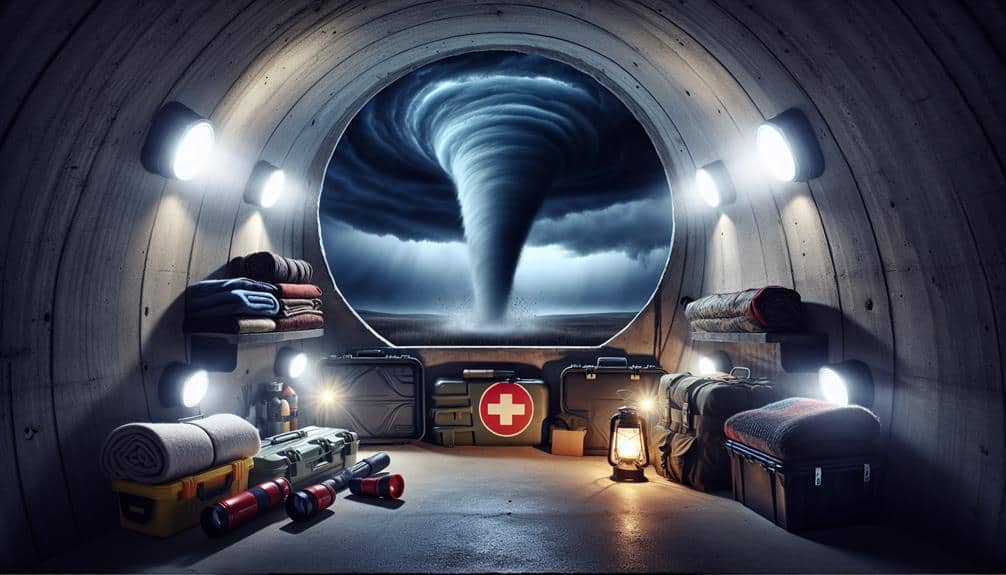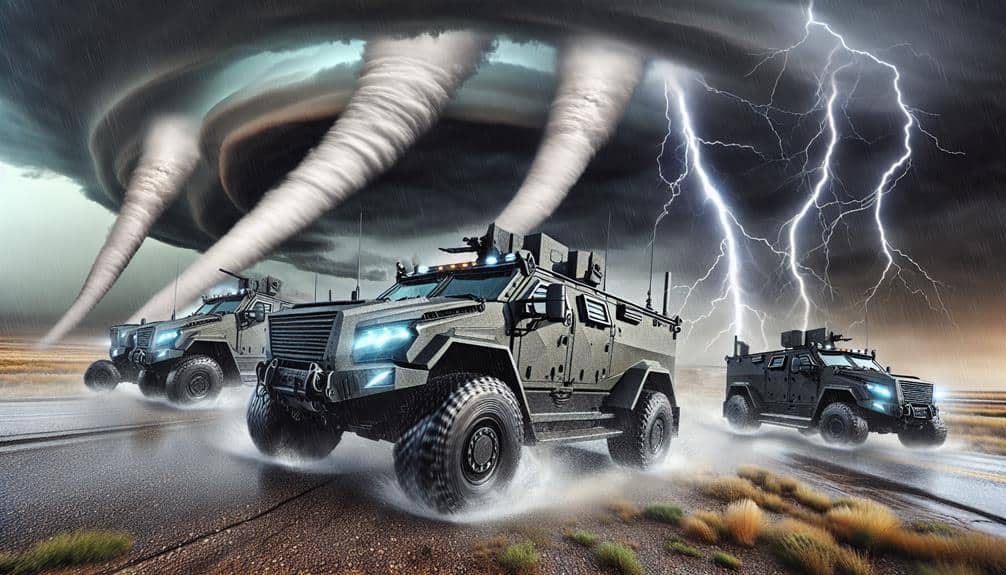We can't underestimate the vital significance of emergency response kits for tornado interceptors. These kits guarantee we're prepared for any situation, equipped with essential survival gear, communication devices, and navigation tools. High-calorie food rations and portable water filtration systems provide sustenance and hydration, essential for prolonged operations in harsh conditions. Medical supplies, from basic first aid to trauma care, enable swift responses to injuries. Moreover, durable shelters and protective gear safeguard us against the elements. Equipped with these tools, we can operate effectively and safely when tracking and intercepting tornadoes. Discovering more about their features can illustrate their indispensable value.
Key Points
- Emergency response kits provide essential supplies for survival and safety during tornado missions.
- High-calorie food rations and water supplies ensure sustained energy and hydration in harsh conditions.
- Medical kits and trauma care items facilitate swift and effective injury response.
- Communication tools like two-way radios and satellite phones ensure seamless coordination and real-time updates.
Safety and Survival Gear
How can we ensure our safety when intercepting tornadoes if we don't have the right safety and survival gear? As tornado interceptors, our freedom to explore and document these powerful storms hinges on detailed emergency preparedness. This means having the right survival gear can make the difference between life and death.
First, we need robust communication devices, such as two-way radios and satellite phones, to stay in constant contact with our team and emergency services. Additionally, having a reliable weather radio ensures we're always updated on storm movements. Personal protective equipment (PPE) like helmets, goggles, and sturdy boots are essential to shield us from flying debris. Durable, weatherproof clothing can keep us dry and warm in harsh conditions.
In terms of survival gear, our vehicles should be stocked with basic necessities: non-perishable food, water, flashlights, and extra batteries. A multi-tool and rope can be invaluable for emergency repairs or securing our equipment. An emergency shelter, such as a portable tent or even a reinforced vehicle, provides a comprehensive refuge if conditions deteriorate rapidly.
Medical Supplies
When intercepting tornadoes, we must carry a detailed medical kit to address any injuries swiftly and effectively. Tornado intercepting is inherently dangerous, and the right medical supplies can be the difference between life and death.
A well-stocked first aid kit is the first line of defense against minor injuries like cuts, bruises, and scrapes. Bandages, antiseptics, and pain relievers are non-negotiable essentials that we need to have readily accessible.
However, we must also prepare for more severe injuries requiring trauma care. This includes having items like tourniquets, trauma shears, and hemostatic agents to manage life-threatening bleeding. Our medical kit should also contain splints and sterile dressings to stabilize fractures and severe wounds.
We can't afford to overlook the importance of having a CPR mask and an automated external defibrillator (AED) in our kit. These tools are crucial for reviving individuals who might suffer cardiac arrest due to the extreme stress involved in tornado interception.
Training on how to use all these items is equally vital, ensuring we're not just equipped but also ready to act.
In essence, a comprehensive medical kit allows us to maintain our freedom to pursue tornado interception while ensuring our safety and readiness to handle emergencies.
Communication Tools
Effective communication tools are critical for tornado interceptors to coordinate their efforts and safeguard everyone's safety. In high-stakes environments, clear and concise communication strategies can mean the difference between life and death. By integrating advanced communication tools in our emergency response kits, we guarantee seamless team coordination and efficient information sharing.
We rely on these tools to maintain constant contact, update emergency protocols, and adapt to rapidly changing conditions. Reliable communication channels help us relay real-time data about tornado movements and other hazards.
To optimize our communication strategies, our kits include:
- Two-Way Radios: Essential for maintaining direct contact when cellular networks fail.
- Satellite Phones: Provide a reliable backup for long-distance communication, especially in remote areas.
These tools collectively fortify our ability to execute emergency protocols swiftly.
When every second counts, having the right communication tools at our disposal empowers us to act decisively and maintain the freedom to navigate perilous situations effectively. By prioritizing robust communication strategies, we enhance our capacity to stay connected and guarantee everyone's well-being.
When intercepting tornadoes, our navigation equipment must be high-quality. We rely on GPS accuracy to make sure we stay on course and avoid hazardous zones.
Real-time weather monitoring is also essential for making split-second decisions and staying safe.
GPS Accuracy Crucial
Accurate GPS navigation is essential for tornado interceptors to safely and efficiently track these unpredictable storms. Our ability to pinpoint exact locations and make split-second decisions can mean the difference between success and disaster. That's why we prioritize both equipment upkeep and rigorous training procedures to guarantee our GPS systems are always reliable.
A malfunctioning GPS unit can lead to serious risks, including getting caught in the storm's path or failing to gather critical data. To mitigate these risks, we adhere to a strict schedule of equipment maintenance. Regular checks and updates are non-negotiable, ensuring our gear functions flawlessly when we need it most.
Equally vital are our training procedures. We train extensively on how to interpret GPS data and respond to real-time updates. This preparedness allows us to navigate complex terrains and rapidly changing weather conditions with confidence and precision.
- Equipment Maintenance: Regular checks and software updates
- Training Procedures: Rigorous and continuous training on GPS usage
Real-Time Weather Monitoring
Utilizing live weather monitoring systems is crucial for tornado interceptors to make informed decisions and stay ahead of rapidly evolving storm conditions. We rely on cutting-edge navigation equipment that integrates data analysis and weather prediction algorithms. This technology allows us to pinpoint the exact location and movement of a tornado, providing essential information in real-time.
Our ability to monitor weather patterns continuously helps us assess risks accurately. By analyzing data from Doppler radar, satellite imagery, and ground-based sensors, we can anticipate a tornado's path and intensity. This information is pivotal for making split-second decisions that ensure our safety and optimize our effectiveness in the field.
Live weather monitoring isn't just about tracking tornadoes; it also helps us navigate safely through hazardous conditions. By staying updated with the latest weather data, we can avoid dangerous areas and find the safest routes. This freedom to move intelligently through storm zones not only enhances our operational efficiency but also markedly reduces the inherent risks.
Shelter and Protection

Ensuring sturdy shelter and protection is crucial for tornado interceptors, as their safety hinges on the structural integrity and strategic placement of their emergency response kits. When we're out in the field, we need to trust that our emergency shelters offer the durability necessary to withstand the most severe weather conditions. These shelters should be lightweight for easy transportation but robust enough to provide a safe haven from the storm.
Protective gear is another essential component. It must balance between safety and comfort, ensuring that we can move freely and efficiently while staying protected. Our gear needs to cover us from head to toe, shielding us from flying debris and harsh elements. Comfort is essential because the gear must be worn for extended periods without hindering our mobility.
Our emergency response kits must include:
- Emergency shelters: Highly durable and easy to deploy.
- Protective gear: Offering maximum protection without compromising comfort.
Emergency Food and Water
When we're in the field, having a reliable supply of emergency food and water is essential for maintaining our energy and focus during prolonged storm tracking. Without sufficient food rations, our cognitive abilities can decline, which compromises our safety and data collection efforts. High-calorie, nutrient-dense food rations like energy bars or freeze-dried meals are compact and have a long shelf life, making them ideal for our unpredictable schedules.
Equally critical is our water supply. Dehydration can impair judgment and physical performance, both of which are non-negotiable when maneuvering high-risk environments. We always carry a minimum of three liters of water per person, per day, to guarantee we stay adequately hydrated.
In addition, portable water filtration systems are indispensable, allowing us to safely utilize natural water sources if our initial supply depletes.
Frequently Asked Questions
How Often Should Emergency Response Kits Be Updated or Restocked?
We should regularly restock and properly maintain emergency response kits every six months. By doing so, we guarantee that all supplies are up-to-date and functional, minimizing risks and maximizing our preparedness for any tornado emergencies.
What Are the Legal Requirements for Emergency Response Kits in Tornado-Prone Areas?
We must guarantee legal compliance and adhere to safety standards for emergency response kits in tornado-prone areas. These regulations safeguard our teams, guaranteeing we're prepared and minimizing risks, while respecting our audience's desire for freedom and security.
Can Emergency Response Kits Be Customized for Individual Needs?
Yes, we can customize emergency response kits to fit personal preferences. Customization options allow us to include specific medical supplies, tools, and comfort items, ensuring that each kit meets individual needs while maintaining overall readiness and safety.
What Training Is Recommended for Effectively Using an Emergency Response Kit?
Training for using an emergency response kit is like arming ourselves for a storm. We should engage in hands-on simulations and practical exercises, complemented by online courses and instructional videos to guarantee technical expertise and clear communication.
Are There Specific Brands or Companies That Specialize in Tornado Emergency Response Kits?
We are aware of top brands and specialized companies like Redfora and Uncharted Supply Co. design tornado emergency response kits. These kits are essential, providing critical tools and supplies to guarantee our safety and freedom during severe weather events.

